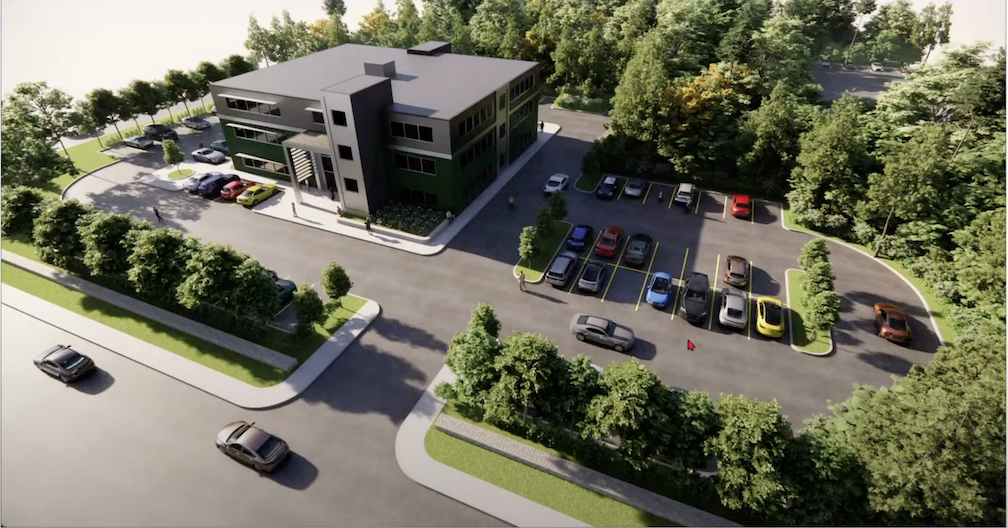At Monday night’s Zoning Advisory Committee meeting, members discussed an updated proposal for rezoning parcels on South Street and voted to move it forward.
Scott Richardson of Gorman Richardson Lewis Architects presented a revised proposal for rezoning 66-70 South Street from residential lakefront property to rural business. He spoke on behalf of Marguerite Concrete, the company looking to develop the properties. Marguerite Concrete’s initial rezoning proposal was rejected at Town Meeting in 2023.
The proposed commercial property would be a three-story, 8,000-square-foot building with 80 parking spaces. It would have one entrance and exit onto South Street.
According to Richardson, the land behind the building would be donated to the town and left as natural plantings. An earthen berm along the rear of the property and “substantial plantings” would be part of the design.
Included in the proposal was a 10-foot buffer strip along Hayward Street. “It would remain as lakefront residential,” Richardson explained. He anticipated the buffer strip would prohibit a future connection onto Hayward Street.
Richardson went on to discuss common inquiries his team has received about the plan. These included questions about use of the building and vehicle traffic. He reiterated that concrete trucks would only be on the property during construction.
“This is strictly office use, which is why we’re proposing rural business and not industrial,” said Richardson.
After Richardson’s presentation, Zoning Advisory Committee (ZAC) chair Ted Barker-Hook set parameters for discussion from board members and residents, stating he “would love not to rehash earlier comments.”
As well, he expressed intent to hold a vote on the proposal that night. ZAC members agreed to the terms.
Members of the committee focused on discussing the proposed Hayward Street buffer. Their concerns centered on whether the commitment to maintain it as residential could be undone if the owner decided they wanted a driveway onto Hayward Street.
“If [the strip] remains residential, does that make it ironclad, or does it just make it harder to put a driveway in?” Barker-Hook asked.
John Gelcich, the town’s principal planner, explained that an open space donation would prevent a driveway onto Hayward Street being installed.

This rendering provided by Marguerite Concrete shows the newly proposed plan for the development of the company’s headquarters at the corner of South Street and Hayward Street.
Jim Marguerite, who was in attendance, stated that he had no issue with donating the strip of land to the town. He is the current owner of the property.
Further discussion by members explored the legal framework for preserving the land on Hayward Street and how the applicant could enter into agreements with the town to protect the space. Richardson explained that Marguerite was open to arranging these agreements as part of the development process.
During the public comment period, residents expressed confusion over why the rezoning application was brought back to ZAC in the first place.
Residents at the ZAC meeting suggested Marguerite consider leasing space from other businesses on South Street. They cited concerns over wildlife, increases in traffic and housing shortages as reasons the committee should deny the rezoning request.
Richardson responded to residents’ concerns about the renewed application.
“The previous application was rushed,” Richardson explained. “We have rethought a more optimal use and development of the property.”
“It got through to Town Meeting through citizen petition,” said Barker-Hook, adding context. “It was never presented to ZAC and the Planning Board, and had very little support by the town.”
Richardson went on to explain that the construction company feels a new development is the best option available.
“They’re looking for owner-occupied, not a lease,” said Richardson. “The other buildings are not appropriate for their needs.”
David Click, Marguerite’s lawyer, explained that the new rezoning request would seek to address residents’ concerns. He reiterated that things like traffic studies and environmental impact reports would be part of the process.
“We want to take as many unknowns out of the equation as possible,” said Click.
Planning board member Parker Happ, speaking as a member of the public, was critical of the notion of rezoning the lot in the first place.
Showing maps pulled from the archives of the Harvard Map Collection, Happ argued that a possible decision to rezone made no sense historically.
“In rezoning this, the board is going against over 100 years of conventional wisdom, and at least 57 years of conventional planning history,” said Happ.
Barker-Hook reiterated to Happ and fellow ZAC members that the committee’s power in making a decision on this application was limited.
“Our only power is to recommend whether the Planning Board can have this discussion,” he said. “There are many, many steps between now and anything happening to that land.”
Once public comment was closed, the committee voted 4-1 to move Marguerite Concrete’s application to the Planning Board stage. Member Vikasith Pratty recused himself due to his status as an abutter to the South Street property.
Committee weighs options for MBTA Communities
Gelcich brought the committee up to speed on zoning options that could meet requirements of the MBTA Communities Act.
He first explained how the proposed downtown district had been expanded since their previous discussions.
It now includes the Domino’s Pizza and Santander Bank buildings on Main Street, along with a small lot on Cedar Street and a vacant parcel behind Town Hall.
“It’s just to grab a little bit more area to see if we can get over the 50-acre requirement with a second, smaller sub-district,” said Gelcich.
He then demonstrated a model that showed how three proposed districts — downtown, Indian Brook Condominiums and Walcott Valley — could be adjusted to meet the state’s requirements.
According to Gelcich, the state requires MBTA community districts to be a minimum of 50 acres and have a 750-unit capacity with 15 units per acre.
The committee discussed the feasibility of each district. Most of the members agreed that a proposal that relied on two districts would be ideal.
“Having to convince the voters on two districts instead of three potentially would have a higher chance of passing,” said member Sam Sader.
Others lamented the lack of what they perceived as good options to meet the state’s requirements.
“While we can get the numbers with Indian Brook, it’s a lousy location,” said Barker-Hook. He cited lack of connection to buses and a likely increase in traffic as reasons to discount it as a district.
Members brought up other properties that could be zoned for inclusion in the project. Gelcich mentioned the Carbone’s property and neighboring parcels at 2 Akins Road and 278 Cedar Street.
Carbone’s would provide the proposed plan with 10 acres, while Akins Road and Cedar Street would offer 4.7 and 15.7 acres, respectively.
“I don’t know if all those would be able to be counted, though,” cautioned Gelcich.
During public comment, Planning Board chair Rob Benson cautioned putting together a proposal that would see the chosen districts developed quickly.
“If we put a proposal [out] that 750 units could be developed in five years, I don’t think the town would vote for it,” said Benson.
Other members wondered about the possibility of not putting a plan forward at all, given potential pushback from residents.
“Our charge is to come up with a plan that complies with the law,” Barker-Hook asserted. “If the voters choose to vote against it and roll the dice against complying, that’s up to them.”
The committee decided to evaluate the other available options before finalizing a plan. Gelcich agreed to prepare two plans — one involving the downtown district and Indian Brook, the other with Walcott, Carbone’s and its neighbors — for review at the next meeting.














This was an absolute farce. The Zoning Advisory Committee looked at proposed development plan (which carries no commitment for any final redevelopment) instead of evaluating why parcels of land historically zoned residential should be re-zoned rural industrial, particularly after a recent town meeting vote clearly had a mandate to keep the parcel residential. The “best” argument presented seemed to be, neighboring parcels are commercial. However, that ignores that we have intermixed commercial and residential along the entirety of Main St. And the largest of the nearby commercial properties to the South Street parcels are grocery stores and restaurants that serve the local residential properties. South Street, currently littered with empty and under utilized commercial properties (until it hits the Milford line where it returns to residential) does not need additional commercial spaces. The ZAC failed to uphold the clearly expressed will of the voters at Town Meeting, and instead bowed in deference to a developer that purchased a residential property with hopes of flipping it to commercial on the cheap. By all means we want Mr. Marguerite to move a successful business to Hopkinton, but there are plenty of existing available options. This was an absolute failure on behalf of the ZAC to uphold the mandate of the voters and passing the buck to other Town Committees doesn’t change that fact.
I want to add, I don’t think volunteering for a committee like ZAC is easy. It’s long hours on evenings away from family, tedious meetings, and a thankless role. No one is holding parades for these folks and it’s great that they are giving of their time and talents. I also understand it’s really hard to say no, particularly when the people asking are decent and reasonable people like Mr. Marguerite and his consultants. But this re-zoning effort should have been nipped in the bud here as the voters made it clear what we wanted and unfortunately now this zombie proposal has to stumble on to the next committee and god forbid another late night vote at a future town meeting.
A landscaping firm bought the land across the street to park their trucks. It’s a decent sized business with about 30 trucks parked there. Are you telling me a landscaping firm could afford to buy that land but a company that wants to build a three story office building couldn’t?
And there’s also an already existing building diagonally across the street that Mr. Marguerite himself said they were asking too much money for. It’s a old metal building that would have to be a teardown but it’s a much more appropriate lot for an office building as it already has access to South Street and the Hayward Street extension that’s on the 495 side of South Street.
This is all about one man getting to buy himself a bigger boat at the expense of ~300 families.